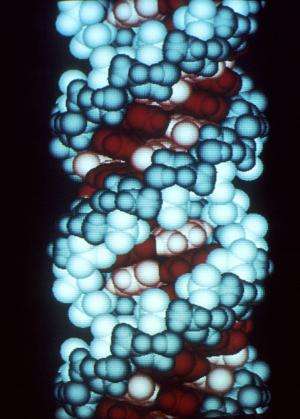Defining the consequences of genetic variation on a proteome-wide scale

Combining two emerging large-scale technologies for the first time—multiplexed mass spectrometry and a mouse population with a high level of natural genetic diversity —researchers at Harvard Medical School (HMS) and The Jackson Laboratory (JAX) can crack an outstanding question in biology and medicine: how genetic variants affect protein levels.
Proteins are chains of amino acids that comprise the structural and functional "parts list" of all cells and organisms. Understanding the regulation of protein expression is therefore critical to understanding normal development and disease. The central dogma of molecular biology describes this transfer of genetic information from DNA to RNA to protein - the DNA sequence is first transcribed into messenger RNA, or mRNA, and then the cell's protein-building machinery translates the mRNA sequences into the amino-acid sequence of the protein.
Given this direct relationship between RNA and proteins, it was widely assumed that protein expression would track closely with mRNA expression. Yet several studies comparing cellular mRNA levels and protein levels have shown a surprising high level of discordance between the two, suggesting that one or more mechanisms act to buffer protein levels from genetic variants that affect mRNA levels. Previous experiments in mice and human cell lines aimed at identifying these mechanisms have been inconclusive.
JAX Professor and Karl Gunnar Johansson Chair Gary Churchill, Ph.D., a pioneer in developing the Collaborative Cross and Diversity Outbred mouse populations, joined forces with Steven Gygi, Ph.D., professor of cell biology at Harvard Medical School, a leader in the rapidly advancing field of quantitative proteomics (the study of an organism's entire complement of proteins), to address this puzzle.
Diversity Outbred mice, bred from eight founder strains, contain extensive genetic variation. "Our mouse populations have more than 50 million SNPs [single nucleotide polymorphisms, variations in individual DNA building blocks]," Churchill says, "and Steve can measure the levels of thousands of proteins instead of dozens. This makes an entirely new scale of analysis possible."
Gygi and Churchill are co-senior authors of an advanced online publication in Nature, "Defining the consequences of genetic variation on a proteome-wide scale," in which they compared mRNA and protein levels in the livers of 192 Diversity Outbred mice.
The researchers identified 2,866 genetic markers that correlate with differences in protein levels across mice (protein quantitative trait loci, or pQTL), and observed two striking patterns. Most proteins with "local" pQTL - the genetic variant influencing protein abundance is located close to the DNA sequence that encodes that protein - showed strong evidence of transcriptional regulation where protein levels tracked closely with mRNA levels. In stark contrast, proteins with "distant" pQTL - the genetic variant influencing protein abundance is located far away from the DNA sequence that encodes the protein - appeared completely uncoupled from their corresponding mRNA's abundance. By applying a novel statistical approach, they showed that the post-transcriptional effects of many distant pQTL could be attributed to a second protein, revealing an extensive network of direct protein-protein interactions and tightly regulated cellular pathways. The researchers confirmed their findings in Collaborative Cross mice.
"We can now uncover relationships among genes, transcripts and proteins not previously known," Gygi says. "Our findings suggest a new predictive genomics framework, combining quantitative proteomics and transcriptomics to infer the proteome-wide effects of a specific genetic variant." Within this framework, he says, researchers can explore and fine-tune pathways associated with their physical process, disease or characteristic of interest.
More information: Joel M. Chick et al, Defining the consequences of genetic variation on a proteome-wide scale, Nature (2016). DOI: 10.1038/nature18270
Journal information: Nature
Provided by Jackson Laboratory

















